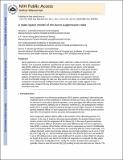A state-space model of the burst suppression ratio
Author(s)
Solt, Ken; Brown, Emery N.; Chemali, Jessica J.; Wong, K. F. Kevin
DownloadBrown_A state-space model.pdf (518.8Kb)
OPEN_ACCESS_POLICY
Open Access Policy
Creative Commons Attribution-Noncommercial-Share Alike
Terms of use
Metadata
Show full item recordAbstract
Burst suppression is an electroencephalogram pattern observed in states of severely reduced brain activity, such as general anesthesia, hypothermia and anoxic brain injuries. The burst suppression ratio (BSR), defined as the fraction of EEG spent in suppression per epoch, is the standard quantitative measure used to characterize burst suppression. We present a state space model to compute a dynamic estimate of the BSR as the instantaneous probability of suppression. We estimate the model using an approximate EM algorithm and illustrate its application in the analysis of rodent burst suppression recordings under general anesthesia. Our approach removes the need to artificially average the ratio over long epochs and allows us to make formal statistical comparisons of burst activity at different time points. Our state-space model suggests a more principled way to analyze this key EEG feature that may offer more informative assessments of its associated brain state.
Date issued
2011-08Department
Harvard University--MIT Division of Health Sciences and Technology; Massachusetts Institute of Technology. Department of Brain and Cognitive SciencesJournal
Proceedings of the 2011 Annual International Conference of the IEEE Engineering in Medicine and Biology Society
Publisher
Institute of Electrical and Electronics Engineers (IEEE)
Citation
Chemali, J. J., K. F. K. Wong, K. Solt, and E. N. Brown. “A State-Space Model of the Burst Suppression Ratio.” 2011 Annual International Conference of the IEEE Engineering in Medicine and Biology Society (n.d.).
Version: Author's final manuscript
ISBN
978-1-4577-1589-1
978-1-4244-4121-1
978-1-4244-4122-8